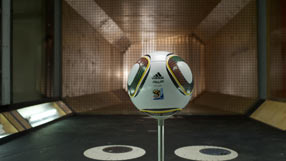Geeks give Jabulani wind tunnel workout
PASADENA - Aerospace engineers at the California Institute of Technology normally test cars and telescopes for aerodynamic differences in their high-tech wind tunnel.

On Wednesday, they tackled a different object: the controversial new Jabulani ball at this year's World Cup.
The brouhaha over the Jabulani - both on the pitch and in the blogosphere - prompted scientists at the Nobel Prize-winning Caltech to test differences between the traditional ball and the upstart.
The two balls were put into the Lucas Wind Tunnel and exposed to wind speeds of about 10 metres per second, slower than a typical kicked ball. A smoke machine was used to visualise to air movement around the ball.
How did the match end? Well, like many games at the World Cup being hosted by South Africa, it was a draw.
Caltech assistant professor of aeronautics Beverley McKeon said it was difficult to say which ball was better but she noted the Jabulani's smoothness could create less drag and therefore less predictable movement.
Created by sport manufacturer Adidas, the Jabulani is seamless and so has a smoother surface, while the old ball has deeper grooves between the panels, creating a more turbulent airflow.
"It's very counterintuitive, but the rougher the ball, the more predictable its trajectory," McKeon told reporters, adding that a smoother ball with higher speeds would not follow as clear a path.
Get FourFourTwo Newsletter
The best features, fun and footballing quizzes, straight to your inbox every week.
CUP COMPLAINTS
Those findings match some of the complaints in the World Cup community where players, coaches and fans have blamed the Jabulani for bizarre trajectories and missed plays.
Spanish striker Fernando Torres complained about the ball after he fluffed several scoring opportunities in Monday's 2-0 win over Honduras in Group H.
"We need to practise a bit more with this Jabulani because we are having a bit of bother with it," Torres told reporters.
Amidst the controversy and tests like Caltech's, Adidas maintained the new ball "meets or exceeds all FIFA approved standards, and tests from the University of Loughborough scientifically prove its unprecedented stable flight and laser-like precision".
McKeon recommends players should just take more time to adapt to the ball's differences.
Like any good scientist, she said more advanced testing is needed to take into account other factors such as spin and increased speed.
That did not stop her, however, from making her own call about why England goalkeeper Robert Green farcically fumbled in his team's opening 1-1 draw with the United States.
"Of course, I can blame it on the ball," she said.
